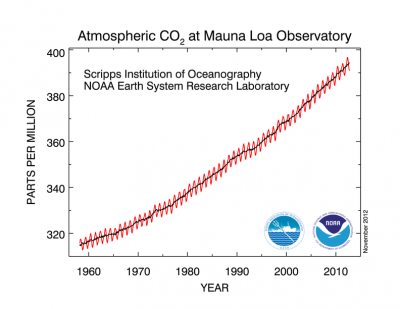Observing climate for Climate Change and Development: what kind of data, how long, and why?
In this blog, Dr. Luisa Cristini, a climatologist at the University of Hawaii at Manoa, draws on her experience working on climate-related disasters in the Asia-Pacific region, to explain the different kinds of observational data gathered by climatologists and how it can be applied to climate change adaptation policies, interventions and related evaluations.
Climate is observed over long time scales, from direct observations or through proxies. Climate is not weather, though the two are often confused. The weather in a certain location is the state of the atmosphere at a particular time. Weather stations monitor various parameters such as air temperature, wind speed and direction, sea level pressure, humidity, and precipitation. The statistic of the weather over a time period of many years defines the climate of a specific location. Meteorological parameters need to be recorded over long time scales for climatologists to be able to analyze them statistically and understand if climate is really changing or if they are just looking at short-term variations due to variability internal to the climate system, like the El Ni-Southern Oscillation. The World Meteorological Organization recommends a minimum of 30 years of weather record to exclude these climate modes.
The climate of the past, before direct observations, can be inferred through the observation of changes in the physical and chemical properties of natural archives, which record climatic patterns. Proxy data is the data paleoclimatologists gather from natural recorders, such like tree rings, lake and marine sediments, ice cores, pollen. From these archives it is possible to reconstruct the climate of a certain period. The compilation of climate data from direct measurements and proxy records can give insights on long-term climate changes. An example is given by the atmospheric carbon dioxide (CO2) measurement at the NOAA's Observatory on Mauna Loa in Hawaii. The record (shown in the figure below), constitutes the longest direct measurement of CO2 in the atmosphere. Recently, this direct measurement has been combined with data from ice cores in an impressive video showing the history of atmospheric CO2 over the past 800,000 years. The video can be found at the webpage of the Global Monitoring Division of NOAA's Earth System Research Laboratory.
High-resolution (both in time and space) climate observations are extremely important for our understanding of past and current climate changes. In time: to exclude short-term variations and have long time series that allow more precise statistical analysis. In space: to have a fine global grid that covers as many locations as possible. Indeed, many places in the world still remain uncovered by weather stations (e.g., because they are remote) and this represents an ongoing challenge.
Numerical models for future climate projections can also be evaluated with this kind of data. For example, climate observations can be used to the models as well as to test their results. Often, datasets of certain parameters (e.g., CO2 concentration) are included in model simulations as input when we need to focus on other aspects of the experiment (e.g., how the temperature changes). Furthermore, climate models, in order to be eligible to simulate future projections, need to demonstrate their ability to simulate past changes in climate, that are inferred or reconstructed through observations. Such test is sometimes called model calibration. Climate observations are also very important to understand climate changes in those areas of the world where results of different climate models disagree.
But how is this relevant to climate change and development practices? Climate data is important for a variety of reasons: to keep track of the changes in the Earth system and in its subcomponents (atmosphere, ocean, cryosphere, biosphere, land), to understand what are the causes of the changes, how the various subsystems are interconnected, and to describe the environmental attributes of a region. This allows us to understand the main vulnerabilities of the ecosystem under study and, in turn, to prepare for potential risks and hazards. Some natural hazards, such as tropical storms, droughts, floods, are likely to be exacerbated by climate change. Therefore, interventions and policies for climate change adaptation in certain areas integrate observations to their vulnerability assessments.
For instance, measurements of sea level rise with buoys and/or satellites are useful to map coastal hazards and to plan shoreline uses. The US Integrated Ocean Observing System, a chapter of the Global Ocean Observing System is a good example of a tool used extensively by climate evaluators, planners and decision-makers in the US to plan marine operations, assess coastal hazards, understand and adapt to climate change and manage ecosystems, fisheries and water quality. The advantage of using climate data, for climate evaluators in particular, lies in the possibility to assess changes in the environment on various time scales as well as to examine the results of adaptation actions and measures.
However, in order to avoid misinterpretation and, in general, misuse, the analysis and interpretation of climate data needs to be conducted by climatologists (meteorologists, oceanographers, paleoclimatologists), who have the knowledge and the instruments to draw the right conclusions.
Figure: Monthly mean atmospheric carbon dioxide at Mauna Loa Observatory, Hawaii. The carbon dioxide data (red curve), measured as the mole fraction in dry air, on Mauna Loa constitute the longest record of direct measurements of CO2 in the atmosphere. They were started by C. David Keeling of the Scripps Institution of Oceanography in March of 1958 at a facility of the National Oceanic and Atmospheric Administration. The black curve represents the seasonally corrected data. Data are reported as a dry mole fraction defined as the number of molecules of carbon dioxide divided by the number of molecules of dry air multiplied by one million (ppm).
Luisa Cristini, an Italian national, is an expert in climatology. She has a Ph.D from the University of Bremen, Germany, and has carried out research in climate modeling and future climate projections at the Max Planck Institute for Meteorology in Hamburg, before moving to the University of Hawaii at Manoa where she investigated climate change impacts on Hawaii's coastal communities and economy. She is currently working on climate-related disasters and natural hazards in the Asia-Pacific region and on developing strategies to adapt to a changing climate and to enhance community preparedness and environmental resilience.cristini@hawaii.edu



